Saturated fat: Is it good or bad for you?
Saturated fat can create quite the dietary dilemma.
For most of your life, you’ve probably been told it’s unhealthy. That saturated fat clogs your arteries and leads to heart attacks.
On the other hand, type in the right Google search words, and you’ll find research-based articles that say that thinking is outdated and wrong.
A frequent claim: The idea that saturated fat is “bad” was based on bad science, and that, in reality, it’s perfectly healthy. So healthy, in fact, you don’t need to restrict it. (Some say you should even eat more of it.)
There’s also this: Foods that contain saturated fat often taste delicious.
You get the picture.
It’s enough to leave you standing in your grocery store’s butter section, frozen in indecision. In the end, maybe you grab a stick but secretly wonder if you’re holding a grenade.
Like many other things we eat (carbs! red meat! soy!) saturated fat is… controversial.
But in order to make informed food choices for yourself and your family—or if you’re a coach, help your clients do the same—you want some clarity.
Here’s the truth about saturated fat.
++++
Why do we think saturated fat is bad?
In 1978, the Seven Countries Study was published. This study, led by American physiologist Ancel Keys, noted:
- a higher incidence of heart disease in countries where the consumption of saturated fats was high (like the US)
- a lower incidence of heart disease in countries where the consumption of saturated fats was low (like Italy, Greece, and Spain)
From this observation, Keys hypothesized that saturated fats cause cardiovascular disease (CVD), and should be avoided. He also proposed that unsaturated fats from plants were protective, and should be emphasized.
(Cool fact: These observations led to the concept of the Mediterranean diet.)
It’s in large part due to the Seven Countries study and Ancel Keys that we have this association between saturated fats and heart disease.
But is it true?
Well, yes, but it’s complicated. If you’ve been following us for a while, you may have noticed that nutrition science is seldom black or white.
For example, it’s rare that we can say one entire category of food is “bad” for everyone—or, for that matter, “good” for everyone. (Learn more: Why we’ve told 100,000 clients: There are no “bad” foods.)
The same is true of saturated fat. While for some people it may increase cholesterol and risk of cardiovascular disease, for others, it doesn’t.
And, as with many other things, “it’s the dose that makes the poison.”
Excess saturated fat isn’t good for anyone. (But that advice applies even to less controversial things, like water, so we’re not saying anything interesting there.)
It’s been about half a century since Keys made his observations. Since then, science has continued to chip away at the truth about saturated fat.
We’ll tell you everything we know, including what saturated fat does in the body, what foods it comes from, and how much of it to eat.
Fats: A crash course
Before we discuss the different types of fats, let’s zoom out and talk about fats in general. (If you’re aren’t up for a biochemistry lesson, you can skip right to the next section if you want.)
All fats are composed of fatty acids and a compound called glycerol. Fats we eat tend to have one glycerol “backbone” with three fatty acids attached to it. These are known as triglycerides.
To help you visualize, when drawn, the chemical structure of a triglyceride looks a lot like a capital letter “E” (the arms of the “E” are fatty acids).
See?
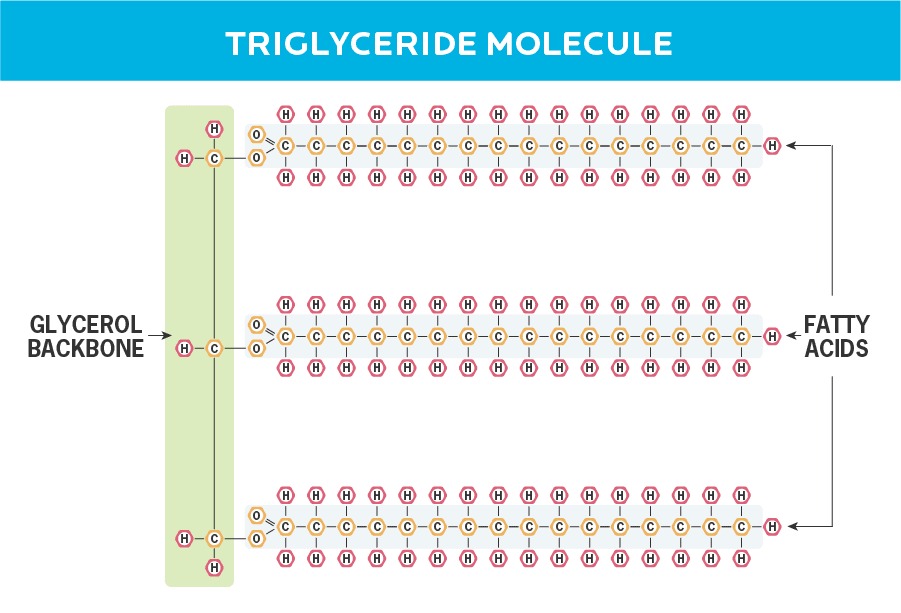
Each fatty acid is composed of a “chain” of carbon atoms that are chemically bonded to each other.
This “chain” can be 2 to 24 carbon atoms in length. In other words, fatty acids can vary in size.
What’s more, each carbon atom has two open “spots” where it can bond with up to two hydrogen atoms.
How these spots are filled are what determines a fatty acid’s chemical structure. (Sometimes, hydrogen only fills one of the two open spots.)
If you had to re-read that a couple of times—and still don’t quite get it—don’t worry. For one, that’s normal. This is abstract stuff. (We’re talking about atoms!) And secondly, it doesn’t really matter.
Just know this: The terms “saturated,” “monounsaturated,” and “polyunsaturated” all describe fatty acids with slightly different chemical structures, due to the kinds of bonds they have.
These structural differences in chemical structure result in different functions and effects in the body.
What are saturated fats?
Saturated fatty acids (and fats) are called “saturated” because if you look at their chemical structure, each carbon atom forms a single bond with two hydrogen items.
The result: Their carbon chain is “filled” to capacity (saturated!) with hydrogens. (You can’t fit any more.)
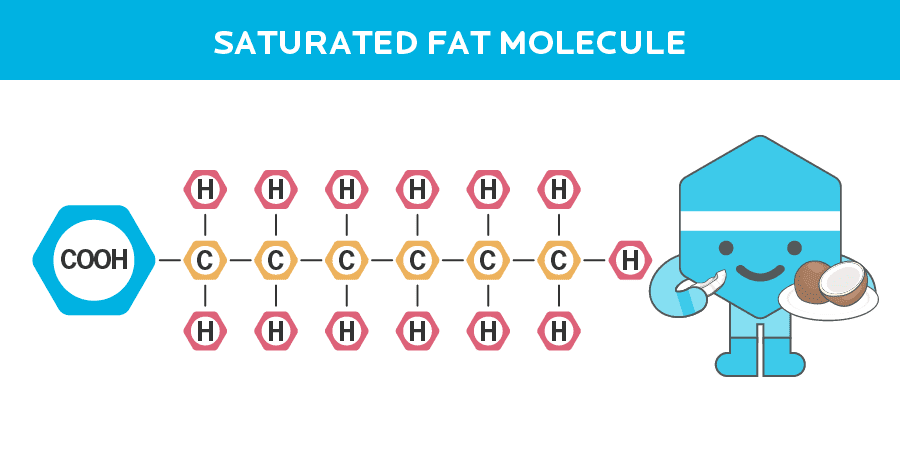
Saturated fat isn’t one single thing. It’s actually a family of many different types of fatty acids.
Remember how we said fatty acids have different chain lengths? You can have 4-carbon saturated fatty acids, 6-carbon saturated fatty acids, 8-carbon… you get the point.
Here are a few examples of types of saturated fatty acids (SFA):
- Butyric acid (a 4-carbon SFA produced by gut bacteria via fiber fermentation)
- Caprylic acid (an 8-carbon SFA found in coconut)
- Palmitic acid (a 16-carbon SFA found in palm oil and animal fats)
- Stearic acid (an 18-carbon SFA found in red meat and cocoa butter)
- Arachidic acid (a 20-carbon SFA found in peanuts)
(Note: We’ve used the common names for these fatty acids. For the scientific names, consult the chart in this nerdy document, courtesy of the Food and Agriculture Organization of the United Nations.)
Saturated fats vs. unsaturated fats: What’s the difference?
Unsaturated fats include monounsaturated fats and polyunsaturated fats.
Monounsaturated fats have one double bond (thus the prefix “mono”) because two spots aren’t taken up by hydrogen. (When two carbons have an open spot, they form a double bond with each other.)
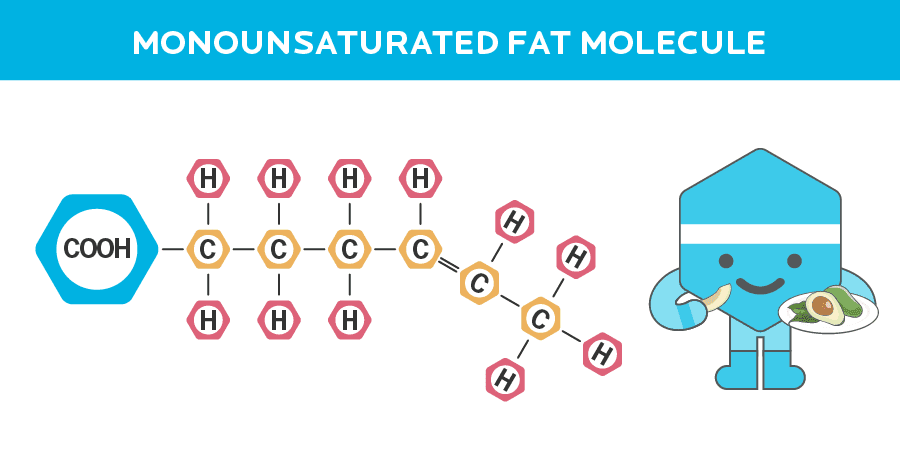
Polyunsaturated fatty acids have multiple double bonds (thus the prefix “poly”), because they have multiple spots that aren’t taken up by hydrogens.
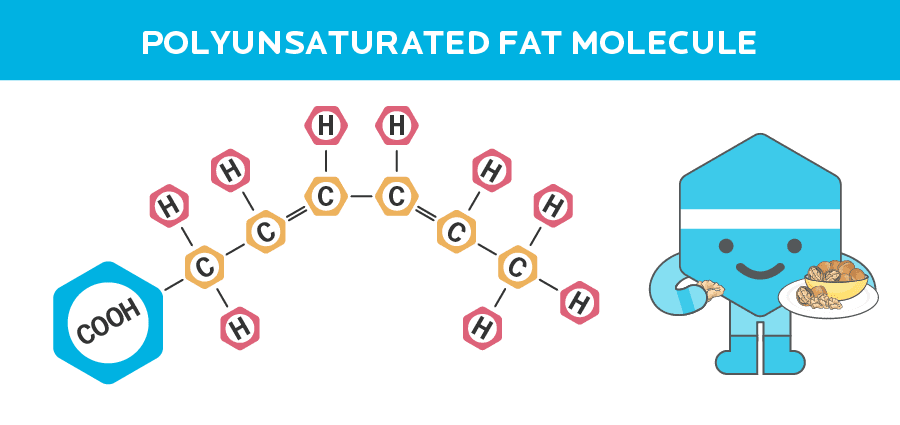
Here’s an easy way to tell if a fat is saturated or unsaturated:
If it’s solid or semisolid at room temperature (21℃), it’s probably saturated. (There are a few exceptions.) Think: butter, coconut oil, and cocoa butter.
If it’s liquid, it’s very likely unsaturated. For example, sunflower oil, canola oil, and olive oil.
This is why: Because unsaturated fatty acids have one or more double bonds, there’s a “kink” or a bend in their physical shape. They can’t pack together as tightly, making them ”loose” and liquid at room temperature.
Meanwhile, saturated fatty acids are straight, and can pack tightly together. That keeps them solid at room temperature.
Most dietary fat sources are made up of some combination of saturated, polyunsaturated, and monounsaturated fatty acids.
Trans fats: The real “bad” fat
The last type of fat is trans fatty acids. And if there’s one type of fat you want to avoid, it’s this one.
Trans fatty acids are usually the product of industrial food processing, where polyunsaturated fats are artificially “saturated” with extra hydrogen.
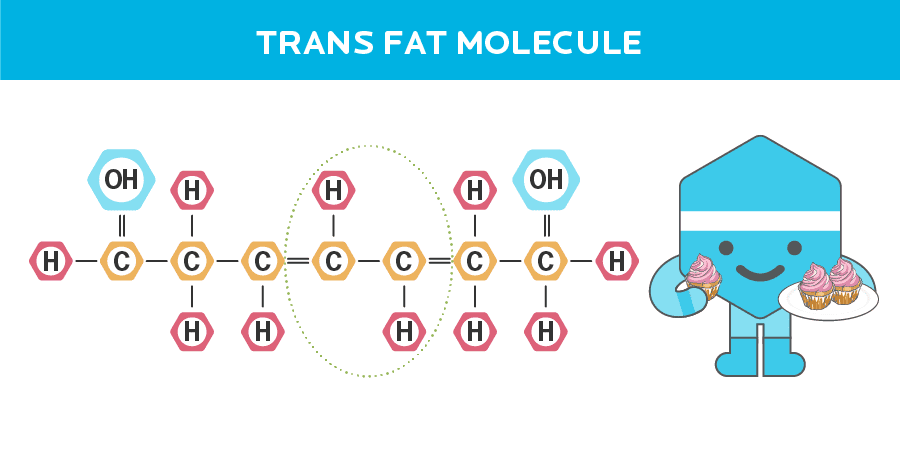
As we’ve seen, the chemical structure of saturated fatty acids makes them straight, while the chemical structure of unsaturated fatty acids gives them at least one bend. This shape affects their function in the body.
When unsaturated fatty acids go through chemical hydrogenation, the fatty acids take a trans configuration, which straightens the molecule so that it looks (and acts) more like a saturated fat.
Food manufacturers like using trans fatty acids in their products because it extends the shelf life of a food.
Human bodies though, don’t deal with trans fats so well.
In fact: Trans fatty acids are directly linked to an increased risk of cardiovascular disease, breast cancer, complications during pregnancy, colon cancer, diabetes, obesity, and allergy.1,2,3
The FDA has even determined that industrially hydrogenated fats are no longer “Generally Recognized as Safe” (GRAS), and have taken steps to have them removed from our food supply.4
However, trans fats are still around. Vegetable shortening, some margarines, some cooking oils, and the processed foods and baked goods made from them all have trans fats.
That’s why it’s still important to read ingredient labels: Any product that lists “partially hydrogenated oil” contains trans fats.
If you’re thinking about your health, you should minimize or avoid these products as much as possible. The World Health Association (WHO) recommends that people limit their consumption of trans fats to 1 percent or less of daily calories.5
Note: There are also a few naturally occurring trans fats, called ruminant trans fatty acids, like conjugated linoleic acid (CLA) and vaccenic acid (VA).
These trans fatty acids get their name because they’re created via bacteria in the stomachs of “ruminant” animals, such as cows, sheep, and goats. Unlike industrially produced trans fatty acids, ruminant trans fatty acids aren’t associated with negative health effects.6
Which foods are high in saturated fat?
As we mentioned, most fat-rich foods are a mix of fats: saturated, monounsaturated, and polyunsaturated.
And actually, even foods that are considered “fats” are a mix of nutrients overall. (For example, avocado also contains carbs and protein in addition to fats, as do walnuts, and most other whole-food fat sources.)
Foods we call “fats” usually have fat as the predominant macronutrient. Similarly, foods we call “saturated fat sources” have saturated fat as the predominant fat type.
Dietary sources of saturated fat
Foods with a higher proportion of saturated fats include:
- Butter
- Whipping cream
- Whole fat milk, cheese, and yogurt
- Coconut (oil, milk, flesh)
- Cacao butter (dark chocolate)
- Fattier cuts of beef, lamb, and pork
- Palm oil
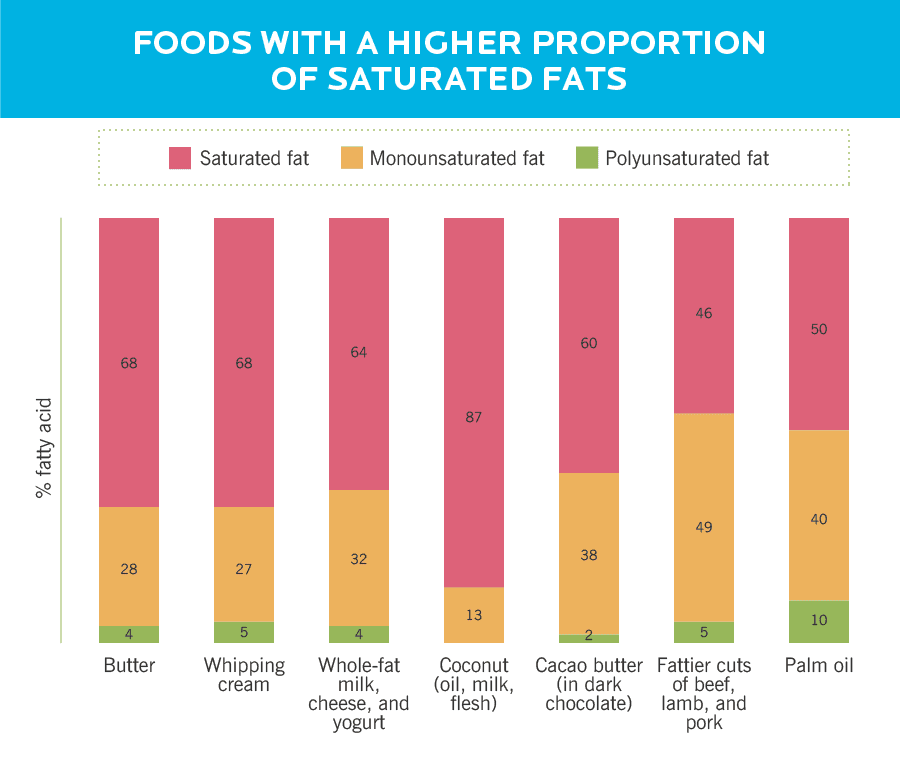
Foods with a higher proportion of unsaturated fats (but still have some saturated fats) include:
- Salmon
- Eggs
- Olive oil
- Flaxseeds
- Avocado
- And others
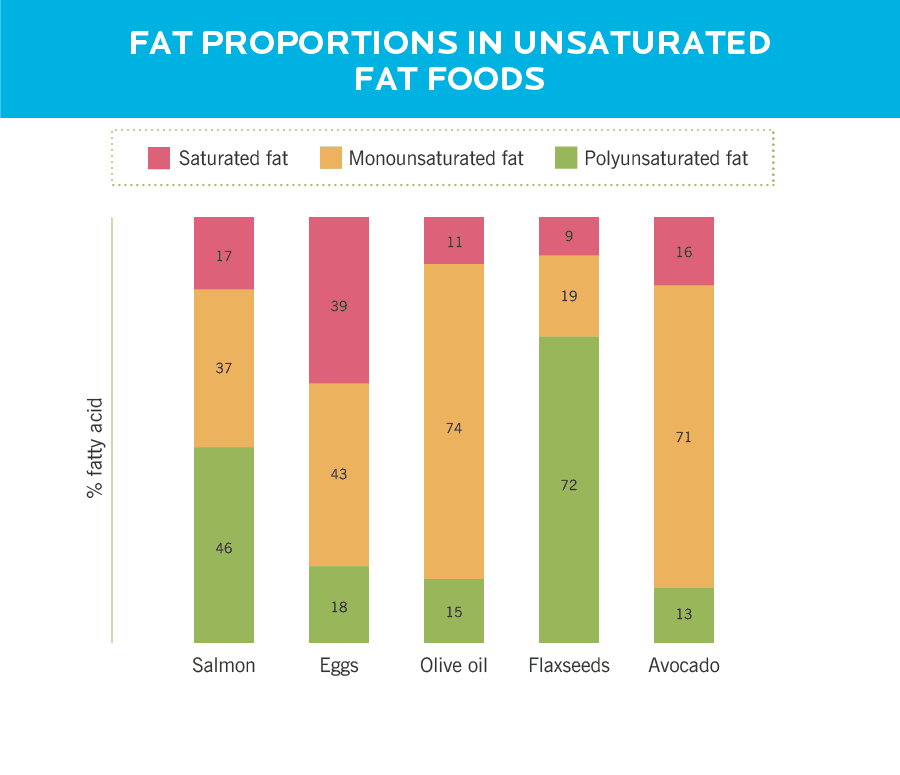
Okay, but will butter kill me faster or not?
Finally, an answer to your burning question.
No. Saturated fats aren’t inherently bad.
A healthy diet will naturally include some saturated fats, because saturated fats are in many healthy foods (such as nuts and seeds, animal products, coconut, and avocado).
But, like most foods, saturated fats are best consumed in moderation.
Here’s why…
Saturated fats, cholesterol, and cardiovascular disease
Those Mediterraneans—the ones observed by Ancel Keys—may have been on to something. With their diets based around vegetables, whole grains, fruits, seafood, olives, nuts, and a little bit of dairy, they showed remarkably low rates of heart disease.
In contrast, the Americans in that study—with their diets rich in saturated fat, meat, dairy, and dessert, and lower in vegetables—had some of the highest rates of heart disease in the world.
With the help of science, we now understand those observations a little better.
Here’s what we know:
 Saturated fats consumed in excess (over 10 percent of daily calories) increase LDL (the “bad”) cholesterol, as well as the likelihood of heart attack, stroke, and cardiovascular events overall.7,8
Saturated fats consumed in excess (over 10 percent of daily calories) increase LDL (the “bad”) cholesterol, as well as the likelihood of heart attack, stroke, and cardiovascular events overall.7,8
As saturated fat intake goes down, so does the risk of cardiovascular events.8
However, saturated fats don’t increase your risk of dying. They also appear to have little to no effect on cancer risk, diabetes, HDL cholesterol, triglycerides, or blood pressure.8
 Trans fats, on the other hand, increase both your risk of cardiovascular diseases and death.9
Trans fats, on the other hand, increase both your risk of cardiovascular diseases and death.9
 Meanwhile, monounsaturated and polyunsaturated fat intake is associated with a lower risk of cardiovascular disease and death.10
Meanwhile, monounsaturated and polyunsaturated fat intake is associated with a lower risk of cardiovascular disease and death.10
What does this all mean?
Well, it means that when it comes to fats, we should:
- Prioritize foods rich in mono- and polyunsaturated fats, like most nuts and seeds, seafood, olives and olive oil, and avocado.
- Moderate foods rich in saturated fats, like fattier cuts of meat, high fat dairy products and the foods made from them, palm oil, and coconut.
- Reduce or eliminate foods rich in trans fats, like processed foods, vegetable shortening, and margarine / cooking oils made with hydrogenated oils.
So, should everyone just cut down on saturated fats?
Most people in Western countries eat a fairly high proportion of saturated fats. So many people should think about reducing their saturated fat intake.
(Also, as far as we know, reducing saturated fats doesn’t seem to have any harmful effects.)8
But…
Cutting back on saturated fat isn’t always a good thing, because it depends on what you’re adding in its place.
We know that when saturated fats are eaten in excess, replacing some of those saturated fats with unsaturated fats can improve health.11
However, when people lower their consumption of saturated fats, replacing those calories with refined carbohydrates, the risk of heart attack goes up.12
Also, not all saturated fatty acids in the saturated fat family have the same effect. For example, stearic acid, a saturated fatty acid found in beef and cocoa butter, seems to decrease or have no effect on LDL cholesterol.13
The reality is this: How saturated fat affects the body is influenced by lots of other things, like:
- Amounts and types of other fats in the diet
- Fruit, vegetable, and fiber consumption
- Calorie excess
- Exercise frequency and intensity
- Stress load and management
- Genetics
And more.
So, it’s complicated.
Based on the body of evidence, it seems that when it comes to keeping dietary fats in a healthy range, we want to consider two things:
- Amount: Not too much and not too little. Roughly 30 percent of your daily calories should come from different types of fat (saturated, monounsaturated, and polyunsaturated).
- Ratio: Aim for roughly equal proportions of saturated, monounsaturated, and polyunsaturated fats.
Specific numbers aside, the take-home message is this: If you’re eating a pretty balanced whole foods diet, and you’re not eating excess calories, you probably don’t need to worry too much about your saturated fat intake.
But, you also probably shouldn’t purposely increase your intake of saturated fats for so-called “therapeutic” effects (example: the butter coffee trend).
That puts saturated fats squarely in the “enjoy in moderation” category.
How much saturated fat should I eat?
As always, the answer is: It depends.
But a good general guideline is that saturated fats should make up about 10 percent or less of total daily calories.14
That means a sample 2,000 Calorie diet can have about 200 Calories—or about 22.2 grams—coming from saturated fats. (Adjust up or down according to your specific energy requirements.)
Here are a couple examples of what this might look like:
- 7 oz sirloin steak = 12 grams saturated fat
- 1 oz chunk of cheddar cheese = 6 grams saturated fat
- 3 large eggs = 5 grams saturated fat
= 23 grams saturated fat
Or:
- 6 oz salmon = 5 grams saturated fat
- 1 tablespoon of coconut oil = 12 grams saturated fat
- 1 avocado = 4 grams saturated fat
= 21 grams of saturated fat
As you can see, it’s easy to meet this 10 percent.
It’s also easy to go over 10 percent, especially if fattier cuts of meat and cooking fats like butter, coconut oil, or palm oil are regulars in your diet.
However, if along with these sources of saturated fat, you’re also getting…
- A good balance of unsaturated fats (from extra virgin olive oil, nuts, and seeds)
- Adequate protein, carbohydrates, and colorful fruits and vegetables from a variety of minimally-processed whole foods (Learn more: “What foods should I eat?”)
- Daily movement from stretching, walking, resistance training, dancing, old-fashioned butter-churning
… you probably don’t have to be anxious about saturated fats.
If you want to find out exactly how much fat—and carbohydrate, protein, and vegetables—your (or your client’s) body needs for your preferred eating style, check out our awesome Nutrition Calculator.
Our big-picture advice for your everyday life: Don’t get too caught up in (or overwhelmed by) the numbers.
Instead, focus on the following four points.
1. Get a mix of fats.
Humans evolved eating a varied and seasonal diet. We thrive best on a mix of fat types—in relatively equal balance—from different types of foods.
This balance comes naturally if we choose a wide selection of diverse, whole, minimally-processed foods that contain fat, such as:
- nuts and seeds
- avocados
- dairy
- eggs
- fatty fish
- beef, pork, and lamb
- poultry
- wild game
- olives and extra-virgin olive oil
Include one or two of the above fat sources at every meal, and you’ll probably meet your fat needs.
2. Avoid trans fats.
Try to minimize or eliminate refined and processed foods containing industrially produced fats and artificially hydrogenated fats (read: trans fats).
This happens naturally the more you center your diet around whole foods. (Learn how: The 5 principles of good nutrition.)
3. Consider the whole person.
Most importantly, match your saturated fat intake to your (or your clients’) unique body, preferences, and needs.
People who have cholesterol or cardiovascular issues in their family may be (genetically) more sensitive to the negative effects of saturated fats, and therefore should limit their consumption.
However, sometimes eating slightly higher amounts of saturated fat is appropriate. For example:
- Larger, more muscular, and more active people can eat proportionately more in general, including more saturated fats. Though, it’s still a good idea to keep saturated fats in the range of 10 percent of total daily calories.
- If it’s meaningful for you or your client to have croissants, dark chocolate, and coffee with cream, don’t “ban” it. Moderate it, understand the tradeoffs, and savor the heck out of it.
- Some people feel good on a higher fat diet. For those folks, eating more fats (including saturated fats) might be appropriate. However, if saturated fats are a main calorie source, consider working with your doctor to test cholesterol levels and blood lipids periodically to ensure they’re in a normal range.
4. When in doubt (but still curious): Experiment.
Above, we suggested limiting saturated fat consumption to about 10 percent of total daily calories.
Now, for most people, that’s a good, conservative recommendation, especially if you have a family history of high cholesterol or cardiovascular disease.
But what if you want to try a higher fat diet—say, the keto diet—and increase your consumption of fats overall?
Well, just try it.
To do this in a way that helps you know whether this kind of diet works for you or not, just adopt this mindset: Think like a scientist.
Decide what outcome you’re looking for while trying a higher fat diet: Reduced cravings? Fat loss? Better energy? (Read more: 3 diet experiments that can change your eating habits—and transform your body.)
Then, take some baseline measurements:
- Weight, girth measurements, photos
- Energy level, sleep quality, digestion, mood (you can simply gauge these on a scale from 1 to 10)
- Cholesterol (LDL, HDL, and total), triglycerides, fasting blood sugar (work with your medical doctor to get and interpret these measurements)
- Anything else you want to track, like cravings or meal satisfaction.
Next, begin your experiment: Increase your fat consumption.
“Check in” every week or two to assess (most of) the above measurements. (If you’re working with a medical doctor to check cholesterol and other blood markers, repeat a blood test after about three months.)
If things seem to be going well for you, keep going. Every few months, evaluate how you’re doing overall.
Feeling and looking better? Avocado and coconut shakes still delish? Blood tests get a thumbs up from doc? Cool! Keep going and re-assess in another six months or so. (For a quick and easy way to determine how your diet is working for you, try our Best Diet Quiz.)
Feeling crappy and blood lipids creeping up? Okay then. Scale back the fat—saturated fat especially.
Tinker with things until you (and your doc) are happy.
Ignore the marketing claims for butter coffee—as well as the ones for celery juice—and see what your own body says.
Most likely, that stick of butter isn’t a grenade. Nor is it a golden elixir of health.
It’s just butter.
jQuery(document).ready(function(){
jQuery(“#references_link”).click(function(){
jQuery(“#references_holder”).show();
jQuery(“#references_link”).parent().hide();
});
});
References
Click here to view the information sources referenced in this article.
1. Oteng, Antwi-Boasiako, and Sander Kersten. 2020. “Mechanisms of Action of Trans Fatty Acids.” Advances in Nutrition 11 (3): 697–708.
2. Souza, Russell J. de, Andrew Mente, Adriana Maroleanu, Adrian I. Cozma, Vanessa Ha, Teruko Kishibe, Elizabeth Uleryk, et al. 2015. “Intake of Saturated and Trans Unsaturated Fatty Acids and Risk of All Cause Mortality, Cardiovascular Disease, and Type 2 Diabetes: Systematic Review and Meta-Analysis of Observational Studies.” BMJ 351 (August): h3978.
3. Dhaka, Vandana, Neelam Gulia, Kulveer Singh Ahlawat, and Bhupender Singh Khatkar. 2011. “Trans Fats-Sources, Health Risks and Alternative Approach – A Review.” Journal of Food Science and Technology 48 (5): 534–41.
4. Center for Food Safety, and Applied Nutrition. n.d. “Trans Fat.” Accessed January 13, 2021.
5. “Nutrition: Trans Fat.” n.d. Accessed January 13, 2021.
6. Gebauer, Sarah K., Jean-Michel Chardigny, Marianne Uhre Jakobsen, Benoît Lamarche, Adam L. Lock, Spencer D. Proctor, and David J. Baer. 2011. “Effects of Ruminant Trans Fatty Acids on Cardiovascular Disease and Cancer: A Comprehensive Review of Epidemiological, Clinical, and Mechanistic Studies.” Advances in Nutrition 2 (4): 332–54.
7. “WHO | Effects of Saturated Fatty Acids on Serum Lipids and Lipoproteins: A Systematic Review and Regression Analysis.” 2016, August.
8. Hooper, Lee, Nicole Martin, Oluseyi F. Jimoh, Christian Kirk, Eve Foster, and Asmaa S. Abdelhamid. 2020. “Reduction in Saturated Fat Intake for Cardiovascular Disease.” Cochrane Database of Systematic Reviews 8 (August): CD011737.
9. Zhuang, Pan, Yu Zhang, Wei He, Xiaoqian Chen, Jingnan Chen, Lilin He, Lei Mao, Fei Wu, and Jingjing Jiao. 2019. “Dietary Fats in Relation to Total and Cause-Specific Mortality in a Prospective Cohort of 521 120 Individuals With 16 Years of Follow-Up.” Circulation Research 124 (5): 757–68.
10. Guasch-Ferré, Marta, Nancy Babio, Miguel A. Martínez-González, Dolores Corella, Emilio Ros, Sandra Martín-Peláez, Ramon Estruch, et al. 2015. “Dietary Fat Intake and Risk of Cardiovascular Disease and All-Cause Mortality in a Population at High Risk of Cardiovascular Disease.” The American Journal of Clinical Nutrition 102 (6): 1563–73.
11. Wang, Dong D., Yanping Li, Stephanie E. Chiuve, Meir J. Stampfer, Joann E. Manson, Eric B. Rimm, Walter C. Willett, and Frank B. Hu. 2016. “Association of Specific Dietary Fats With Total and Cause-Specific Mortality.” JAMA Internal Medicine 176 (8): 1134–45.
12. Jakobsen, Marianne U., Claus Dethlefsen, Albert M. Joensen, Jakob Stegger, Anne Tjønneland, Erik B. Schmidt, and Kim Overvad. 2010. “Intake of Carbohydrates Compared with Intake of Saturated Fatty Acids and Risk of Myocardial Infarction: Importance of the Glycemic Index.” The American Journal of Clinical Nutrition 91 (6): 1764–68.
13. Jesch, Elliot D., and Timothy P. Carr. 2017. “Food Ingredients That Inhibit Cholesterol Absorption.” Preventive Nutrition and Food Science 22 (2): 67–80.
14. Liu, Ann G., Nikki A. Ford, Frank B. Hu, Kathleen M. Zelman, Dariush Mozaffarian, and Penny M. Kris-Etherton. 2017. “A Healthy Approach to Dietary Fats: Understanding the Science and Taking Action to Reduce Consumer Confusion.” Nutrition Journal 16 (1): 53.
If you’re a coach, or you want to be…
Learning how to coach clients, patients, friends, or family members through healthy eating and lifestyle changes—in a way that’s personalized for their unique body, preferences, and circumstances—is both an art and a science.
If you’d like to learn more about both, consider the Precision Nutrition Level 1 Certification. The next group kicks off shortly.
<!—Snippet to hide
If you’re a coach, or you want to be…
Learning how to coach clients, patients, friends, or family members through healthy eating and lifestyle changes—in a way that’s personalized for their unique body, preferences, and circumstances—is both an art and a science.
If you’d like to learn more about both, consider the Precision Nutrition Level 1 Certification.
–>
The post Saturated fat: Is it good or bad for you? appeared first on Precision Nutrition.
Source: Health1
